|
   |
|
Page 6 |
Newsletter 146 Autumn 2024 © Hampshire Mills Group |
|
Mills in Orkney
Ruth Andrews
Photos by Keith and Ruth Andrews
|
In June we spent a cold and windy fortnight driving
to and from Orkney. Very fortunately, in the week
we were there it the weather improved considerably
and we able to visit the major archaeological site
at Ness of Brodgar, where a series of monumental
neolithic buildings are being excavated. Although
this was the main purpose of our visit, we are
always aware that we need to photograph and write
about any mills that we see. We were pleased to
spot several sites which seemed to have very little
written about them, but we also revisited several
better-known examples.
Barony Mill in the north of Orkney Mainland
was built in 1873. It is now the only working meal
mill on Orkney, and chiefly produces bere meal, an
old form of barley which was grown all over Orkney.
All Orkney mills need a large kiln to dry the grain
and at Barony this is particularly noticeable. The
mill’s website
baronymill.com describes the operation:
“Grain received on the ground floor is hoisted to
the top floor for drying in the kiln- about a tonne
at a time. The drying takes between 4-6 hours. A
unique wooden shovel powered by the hoist aids in
removing the grain from the kiln floor. There are
three pairs of stones on the first floor. Grain is
sent to the first pair, the ‘shilling stones’, to
crack the husk, thus freeing the kernel. From here
the grain and husk drops to a ‘fanner – a wind
machine that blows away the husks (locally called
‘scrubs’) – which are burnt to heat the kiln. An
elevator lifts the grain to a second fanner, after
which the grain is delivered to a pair of French
burr stones to be ground into a coarse meal
(locally, ‘grap’) which is bagged, hoisted, and
re-ground by the beremeal stones made from millstone
grit.”
|
 |
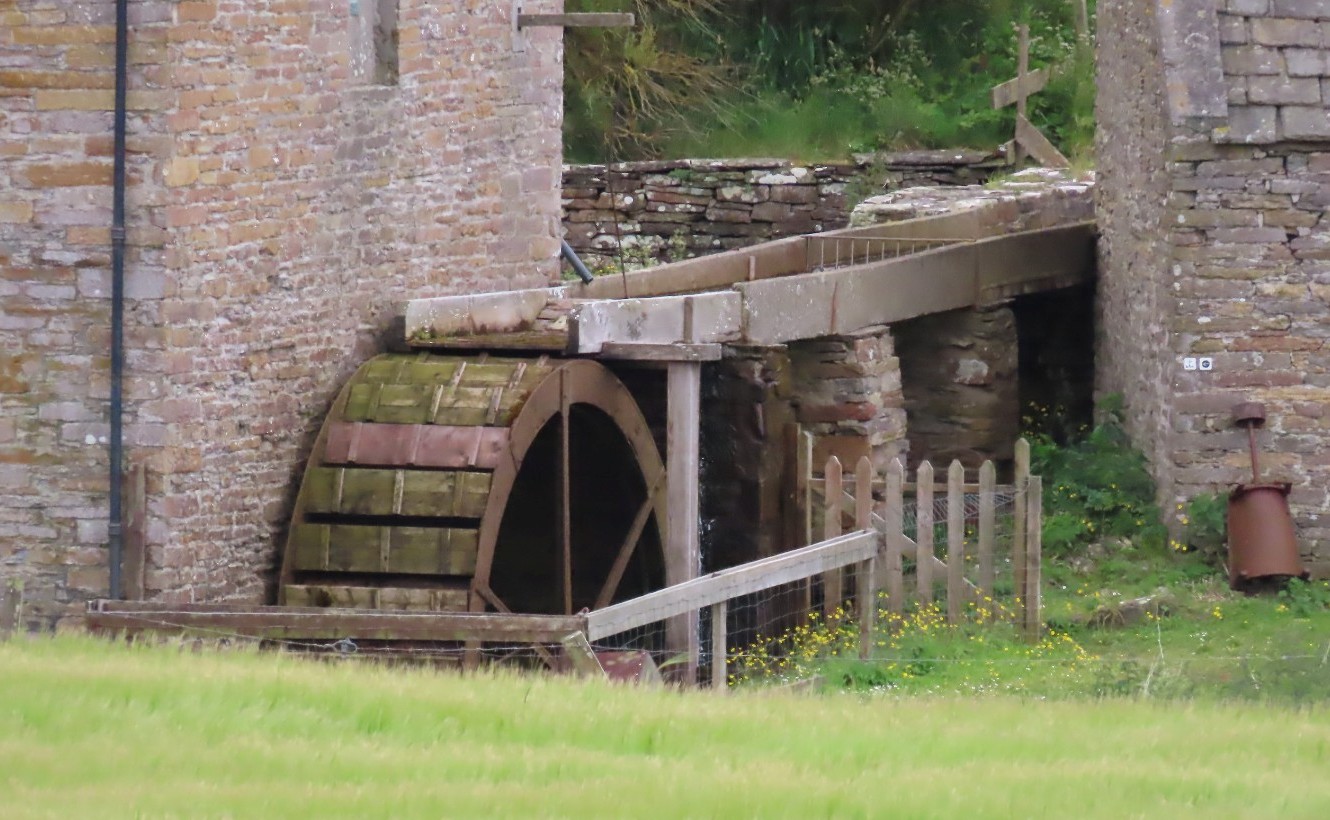
The overshot waterwheel, about 4.1m diameter, turns
at some 12rpm.
The water comes from the nearby Boardhouse Loch. |
As a complete contrast I have
included the horizontal Click Mill near Dounby,
which is a unique survivor on Orkney of a much
earlier type of mill, even though it was built in
the early 1820s to replace an older mill which had
become ruinous. It was repaired by the Orkney
Archaeological Society and handed to the Office of
Works in 1932, since when it has been a guardianship
monument.
It is described as a click mill because a peg on
the millstone catches on the bottom of the shoe
making a clicking sound so that miller can judge the
speed of the stone; it also shakes the hopper to
vibrate the grain down the shoe into the eye of the
stone. The mill is tucked away beside a stream and
is well hidden in the local landscape. This may be
intentional: particularly in the Western Isles,
mills were sometimes deliberately hidden to avoid
payment to landlords.
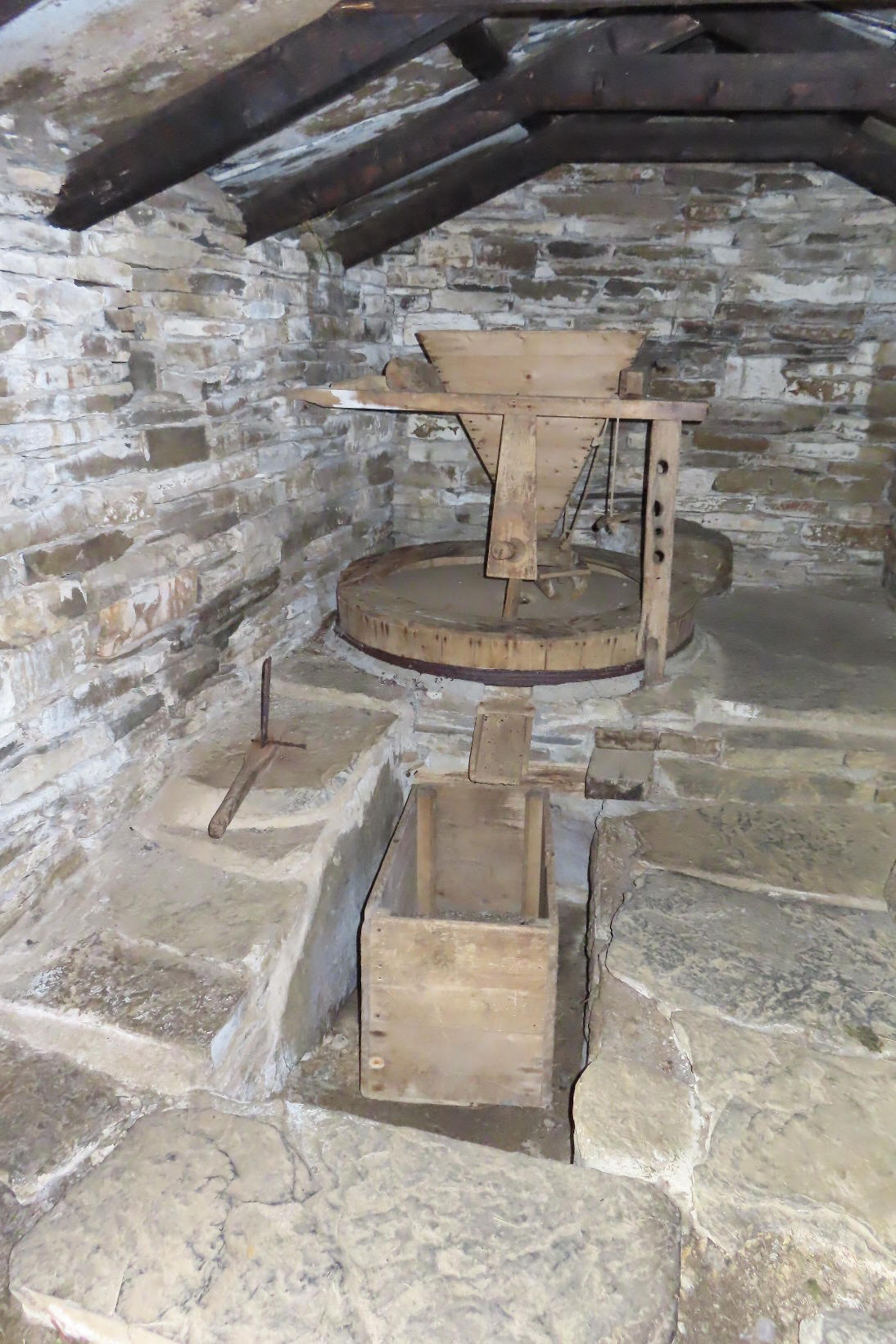 |
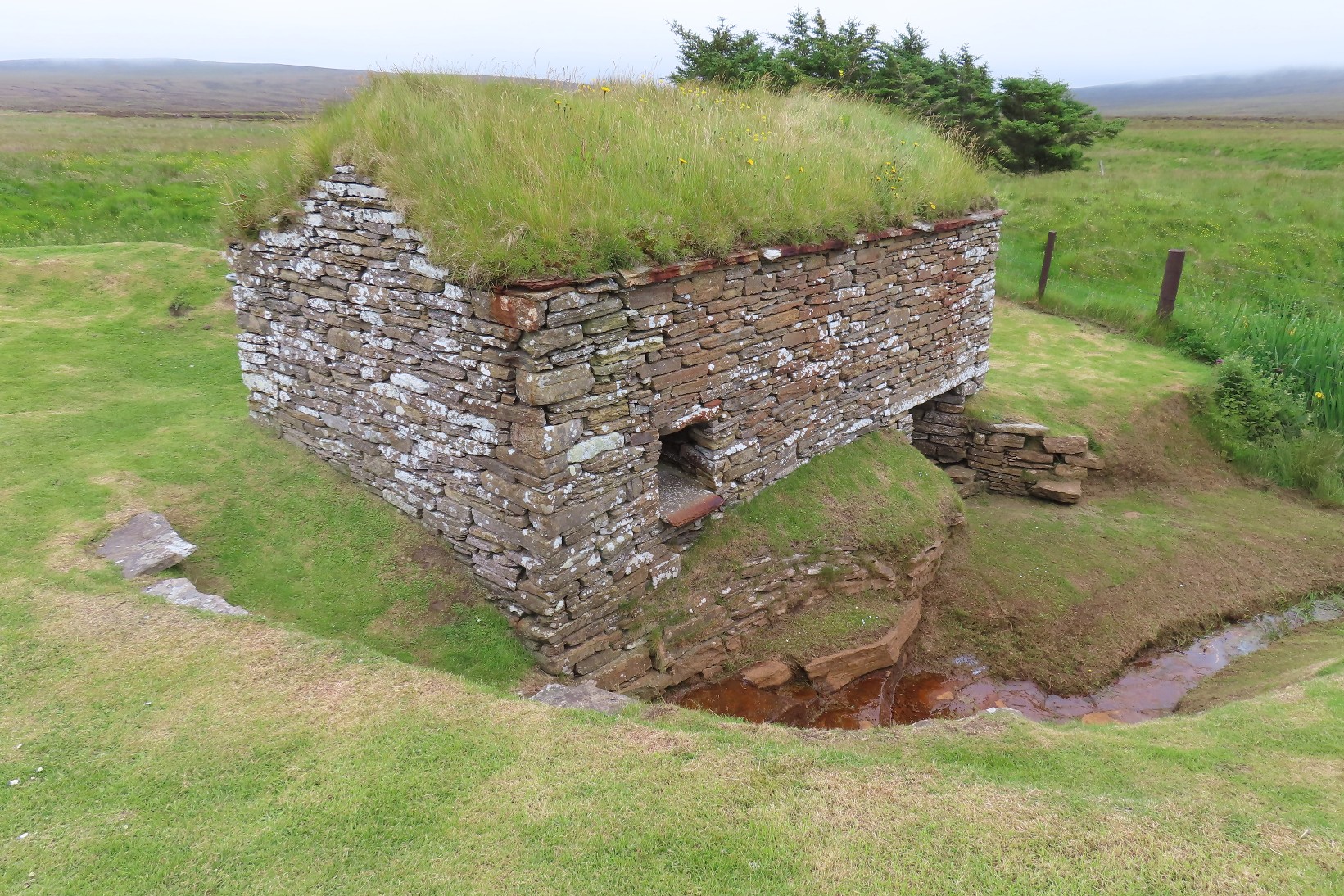
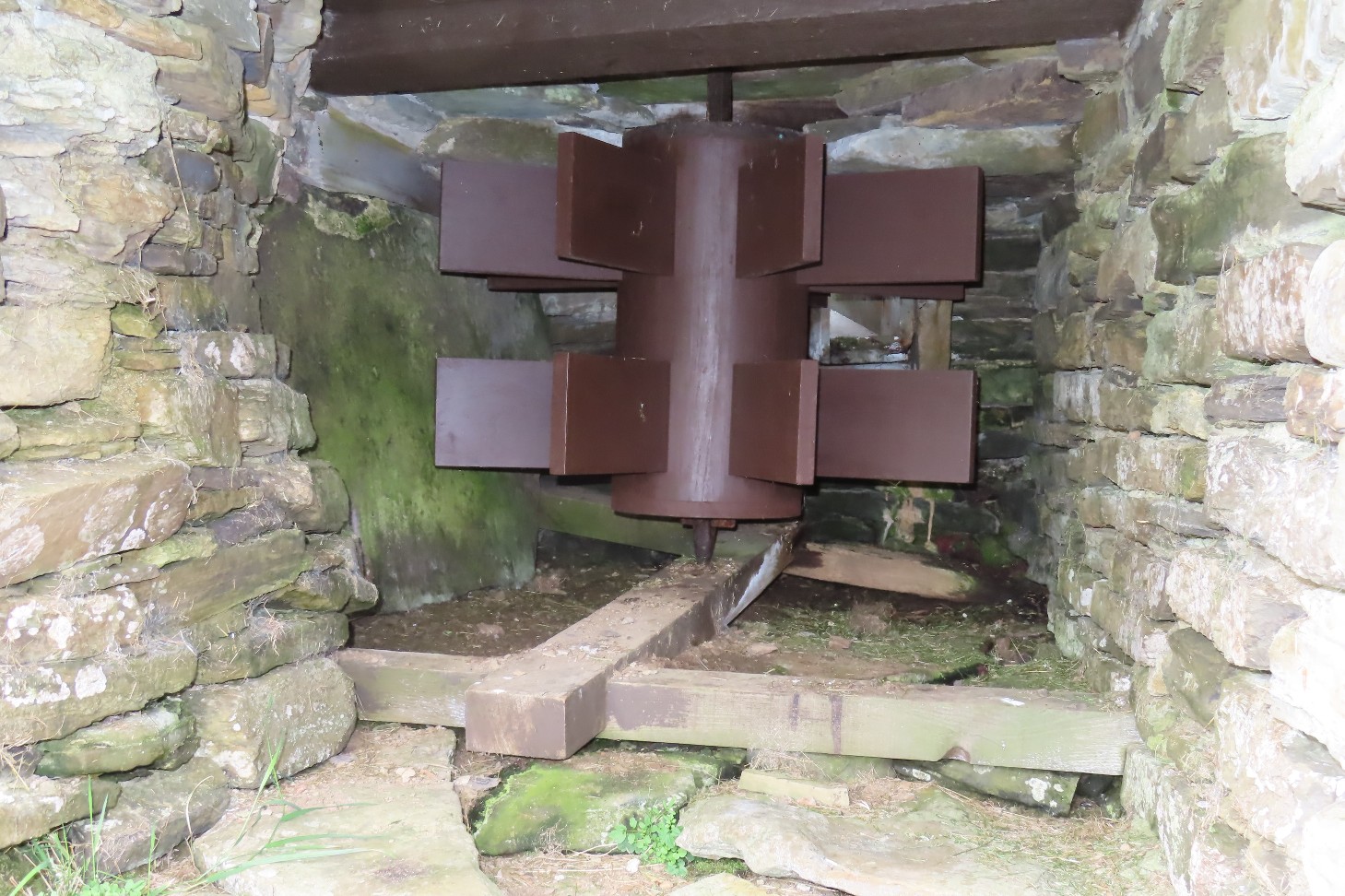
|
|
Now for the less well-known
examples.
On a day trip to Shapinsay island, we
noticed a ‘Mill Dam’ which is a well-publicised bird
reserve. We now know that this was installed in in
the 1880s to provide a controllable source of water
for Elwick Mill, which is now residential, with a
rebuilt waterwheel and an extremely skeletal
windpump.
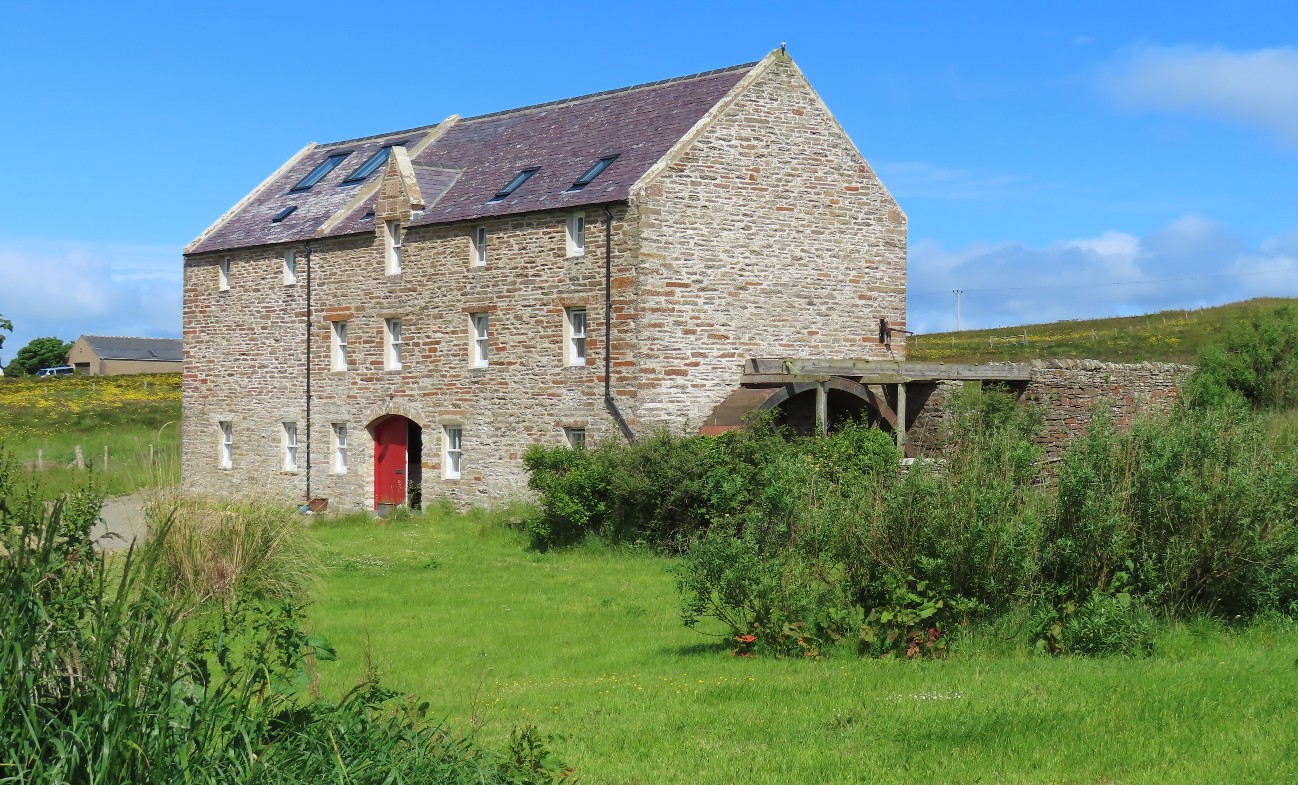
Built in 1883, we assume it was part
of the Balfour estate: David Balfour made his
fortune in India and inherited the Sound estate in
the 1840s which included all of Shapinsay. He built
Balfour Castle and its accompanying farm, gas works,
and so on. The mill was once the largest
water-powered grinding mill in Orkney and it
replaced several small mills to become the meal mill
serving the whole of Shapinsay.
|
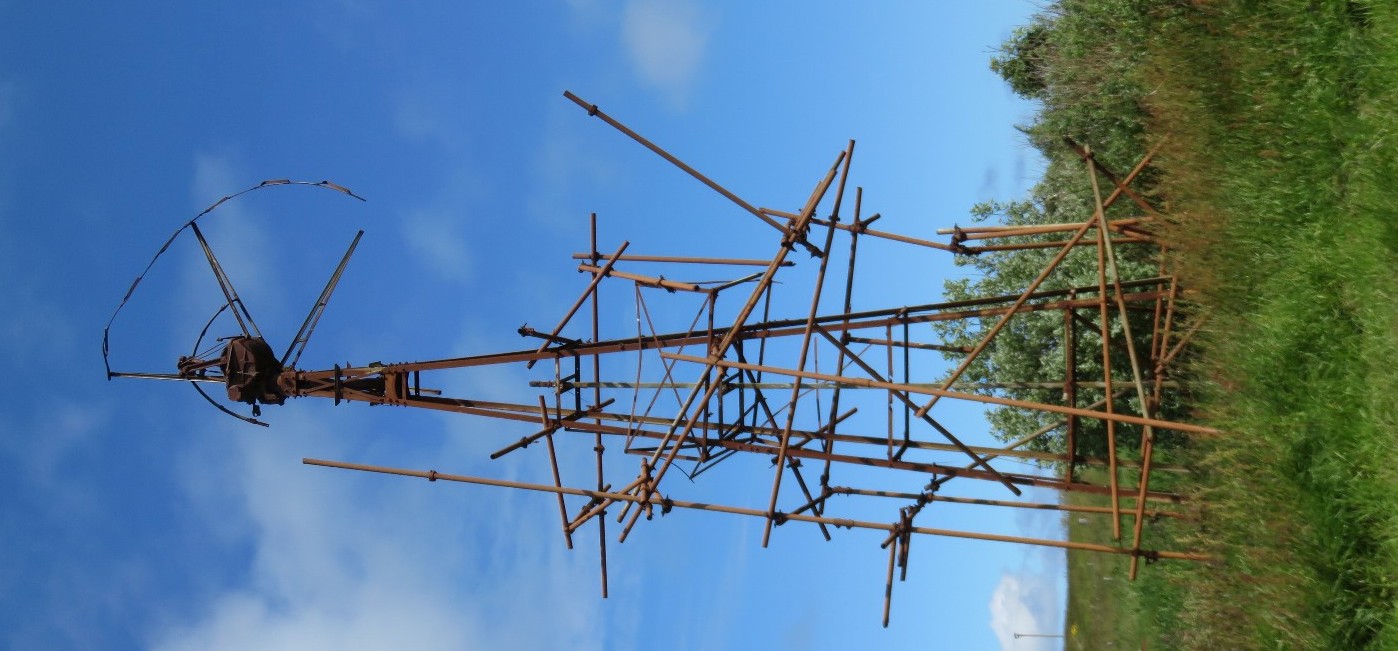 |
|
The only remaining structure of the
gasworks is the gas holder built in mock defensive
style. The gas was used to light Balfour Castle and
the village from 1860 to the 1920s, when the gas
works was demolished.
Returning to Mainland, we passed
Kirbister Mill which was visited by the Scottish
IA Survey in 1981. It is now derelict and for sale.
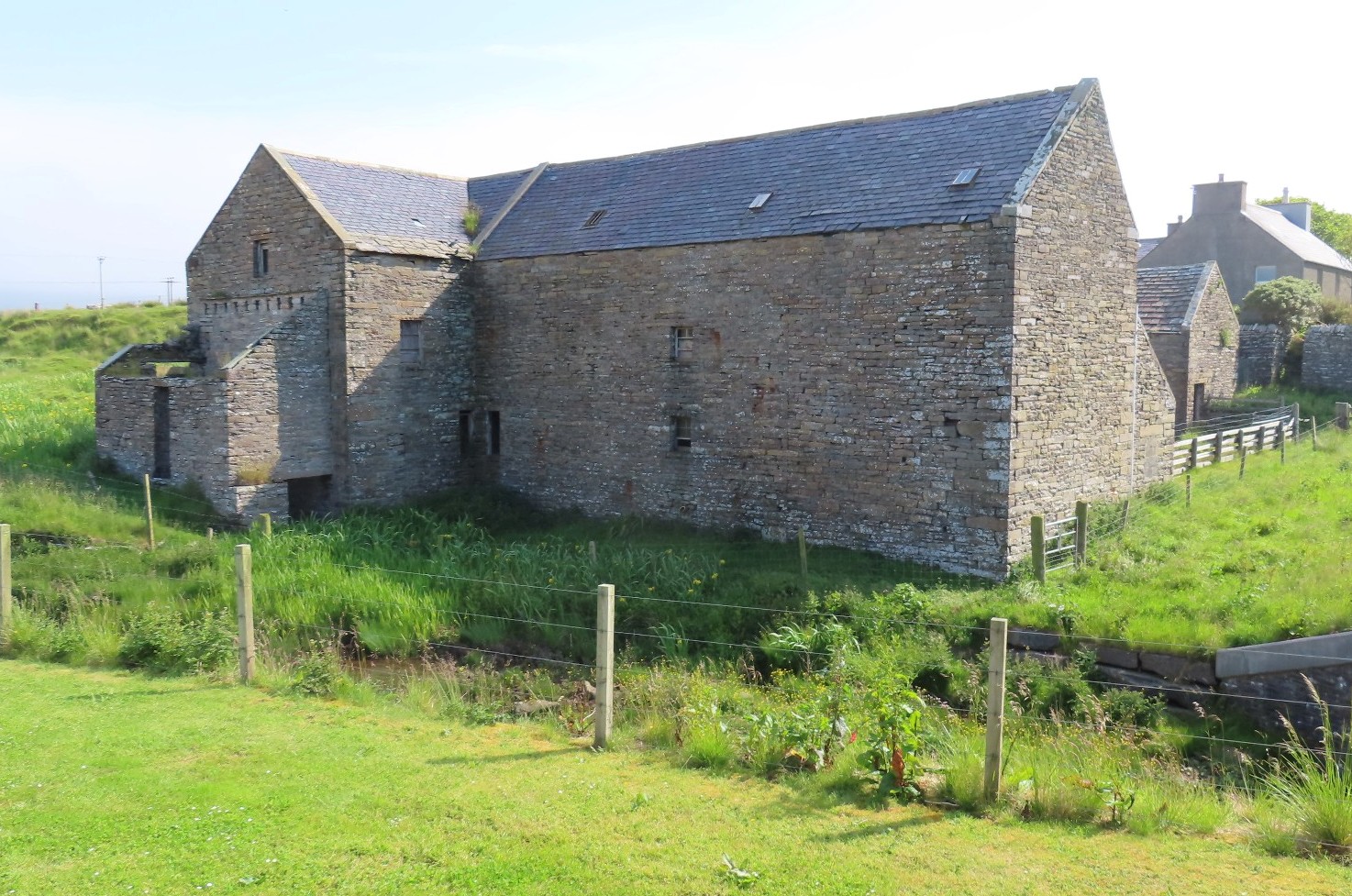
|
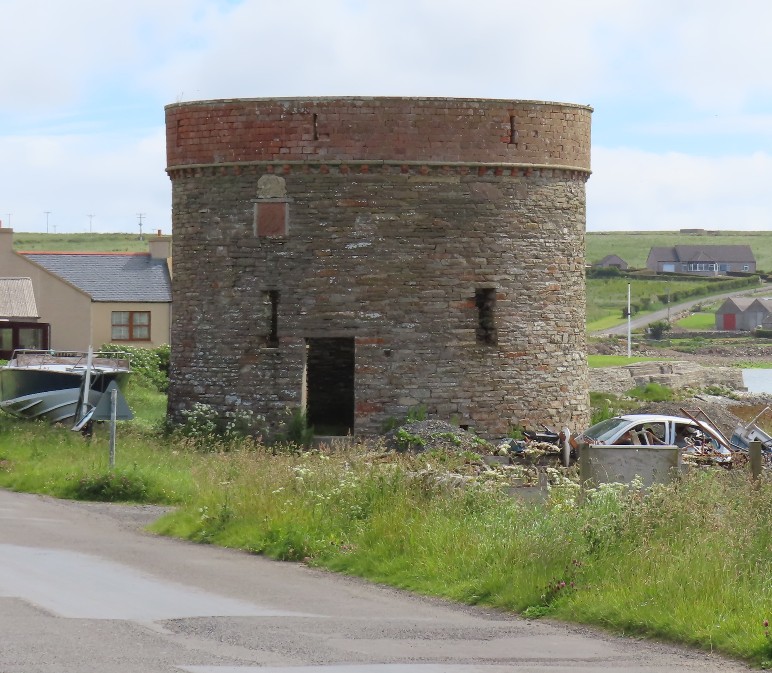 |
|
It is described by Canmore (the
online catalogue to Scotland’s archaeology,
buildings, industrial and maritime heritage) thus:
“This is a random rubble (flag) built
mill complex incorporating two three-storey kilns
and grain mill and a two-storey threshing mill and
byre with hay loft. The enclosed waterwheel
operating the now gone three (probably) millstones
was on the west side of the building. It was an
overshot type with a maximum diameter of 4.6m and a
maximum width of 1.25m. The now filled-in pit of a
second enclosed wheel is situated between the grain
milling area on the west and the threshing mill area
on the east of the complex. This waterwheel, of the
undershot type, probably drove the threshing
machinery and measured 3.6m in diameter and 1.4m in
width.
The kilns were housed in the south
range, the southernmost being an addition (indicated
by differences in the masonry). The framework for
the now gone kiln plates is still in place
indicating that they were 0.3m square. There is a
date stone in the floor of the grain milling area
(first floor) bearing initials and the date 1889.”
|
|
Mill o’ Rango is actually marked on the OS
map and it is an unmissable roadside building.
Again it is 19th century and its most striking
feature is a large pyramidical roofed kiln. It is
now a very desirable residence.
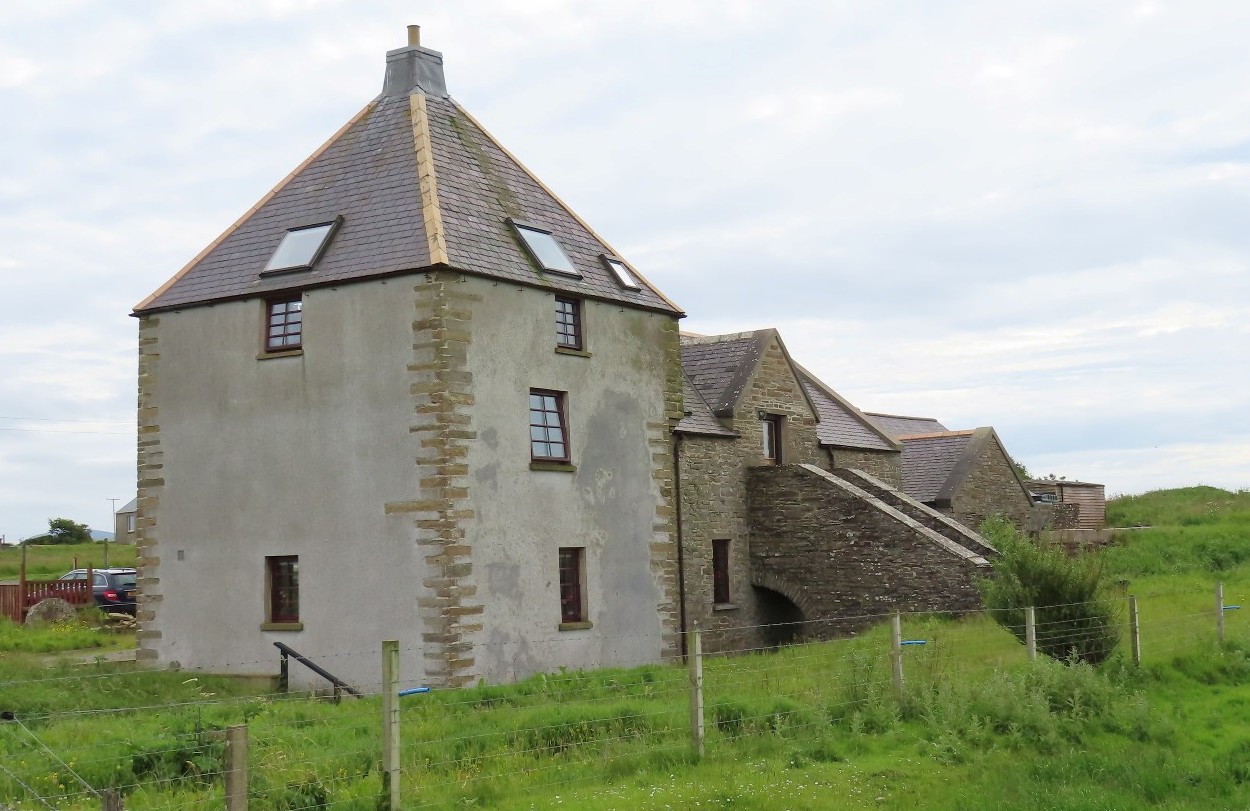
|
 |
|
On the island of Rousay, there was
definitely a waterwheel at Nousty, but we
don’t know its name, and it may have been a farm
power unit rather than a mill.. Again it is
derelict.
|
 |
 |
|
Sourin Mill is also on Rousay and announces
its presence with a 2-storey luccam and rather rusty
scaffolding. It has datestones of 1777, 1861, 1880,
and 1937. Planning notices on the door explain that
it was purchased for restoration in 2020, but
progress seems to have stalled. The original kiln
at the mill became too small, and in 1861 a larger
kiln was built. This was slightly wider than the
mill and slightly higher.
|
 |
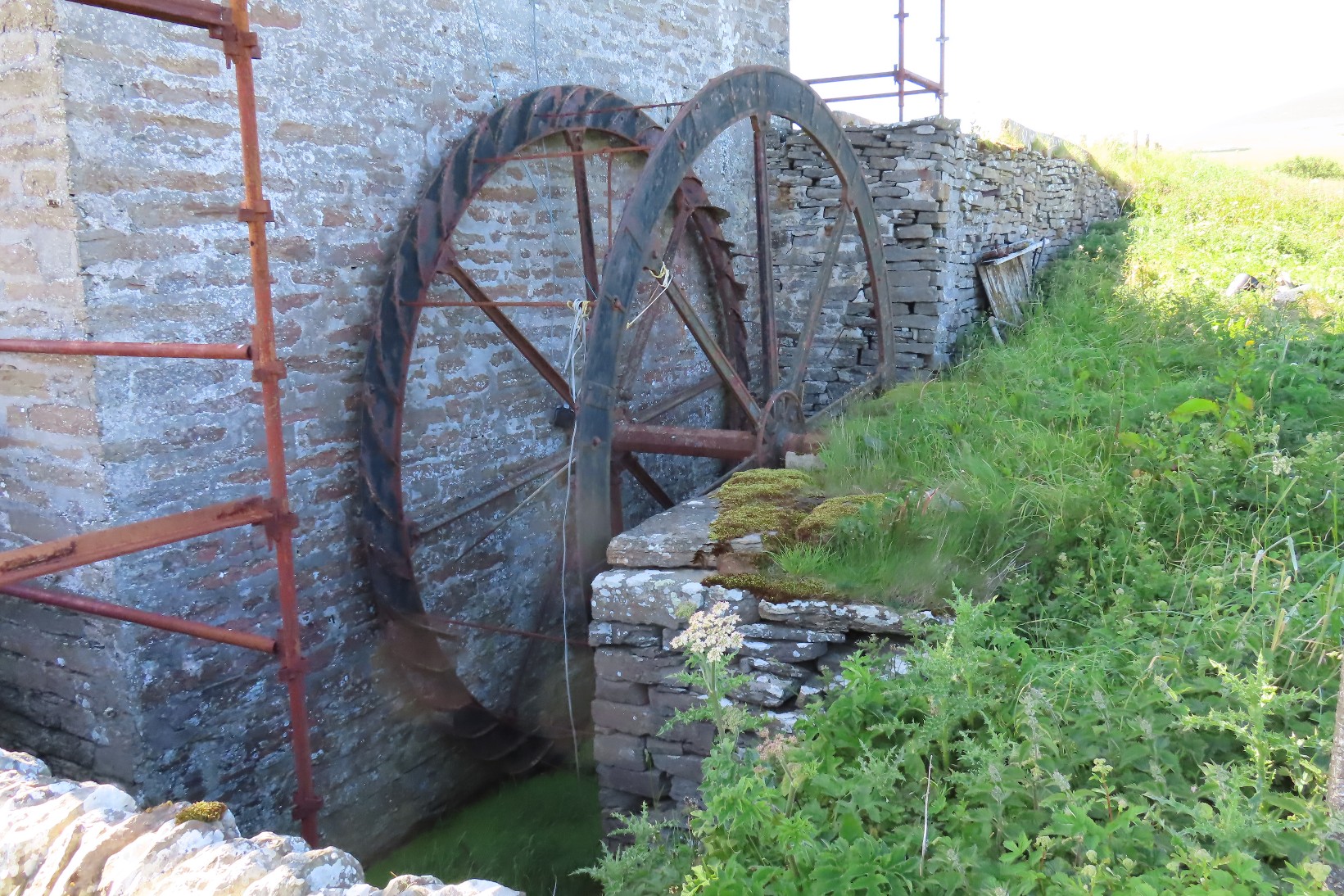
The overshot waterwheel was 14 feet
in diameter, and 4 feet across with 48 buckets.
|
|
Returning again to Mainland, we photographed
Tankerness Mill. It has been much more
thoroughly recorded but is now on the Buildings at
Risk Register. Historic Environment Scotland’s
report says:
“2-storey, 5-bay T-plan asymmetrical
mill with slightly raised kiln at east end and
undershot water wheel at west. Harl-pointed rubble.
Long and short quoins to kiln. The tall blocked
arches mark the position of the original wheel
before it was placed on the outside of the end
wall. 3 pairs of stones were driven by a high-breastshot
wheel about 4.3m in diameter and, in order that the
movement of the wheel did not startle horses passing
over the adjacent bridge, it was shielded by a
screen wall.”
Or was it to shield it from the
strong winds as it was in a rather exposed position?
We were puzzled by an iron bracket on
one of the blocked-up arches. The report says that
the mill had a flat pulley system allowing a drive
from a tractor to power a hammer mill, which was
probably used to bruise grain, so maybe that
explains it.
|
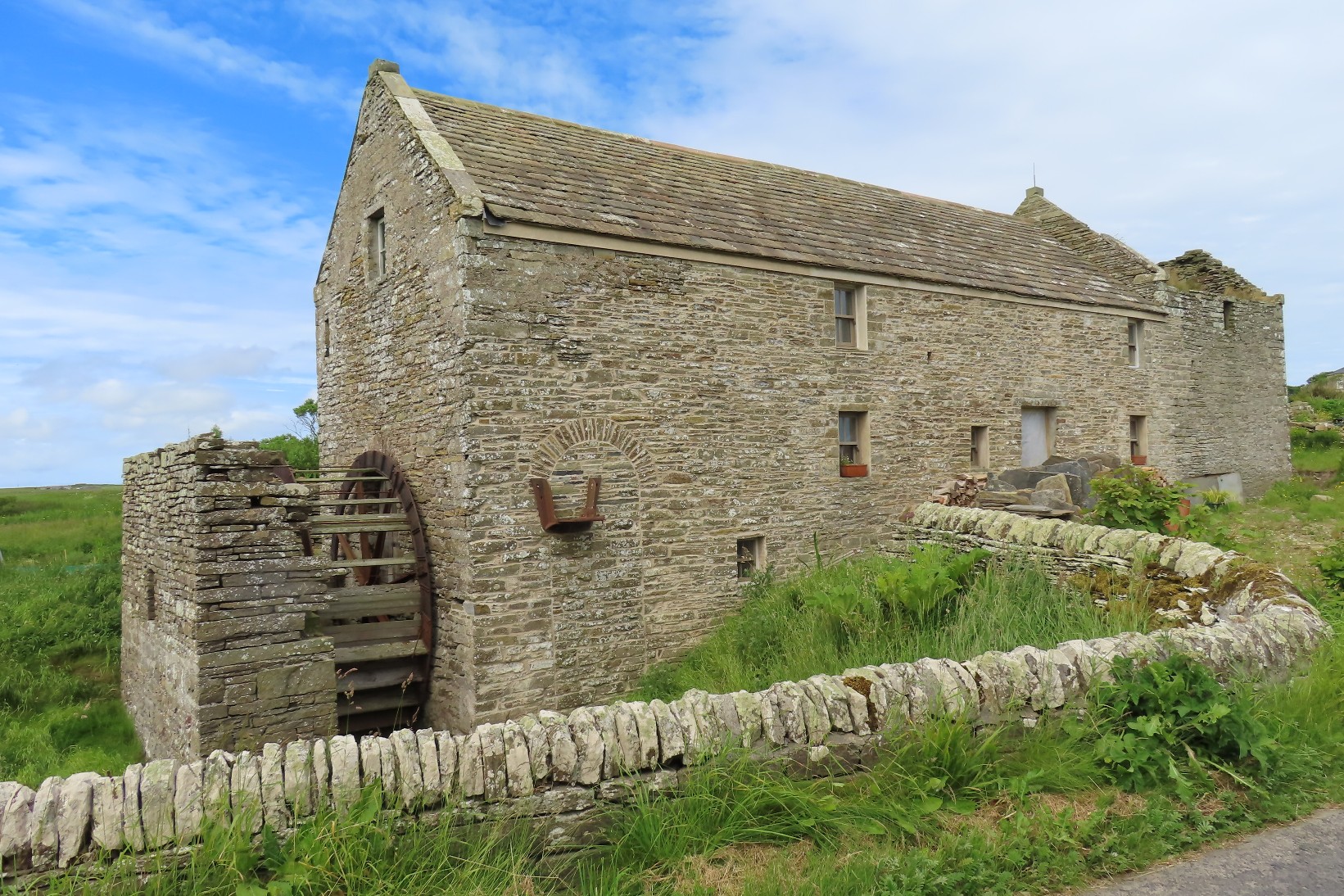 |
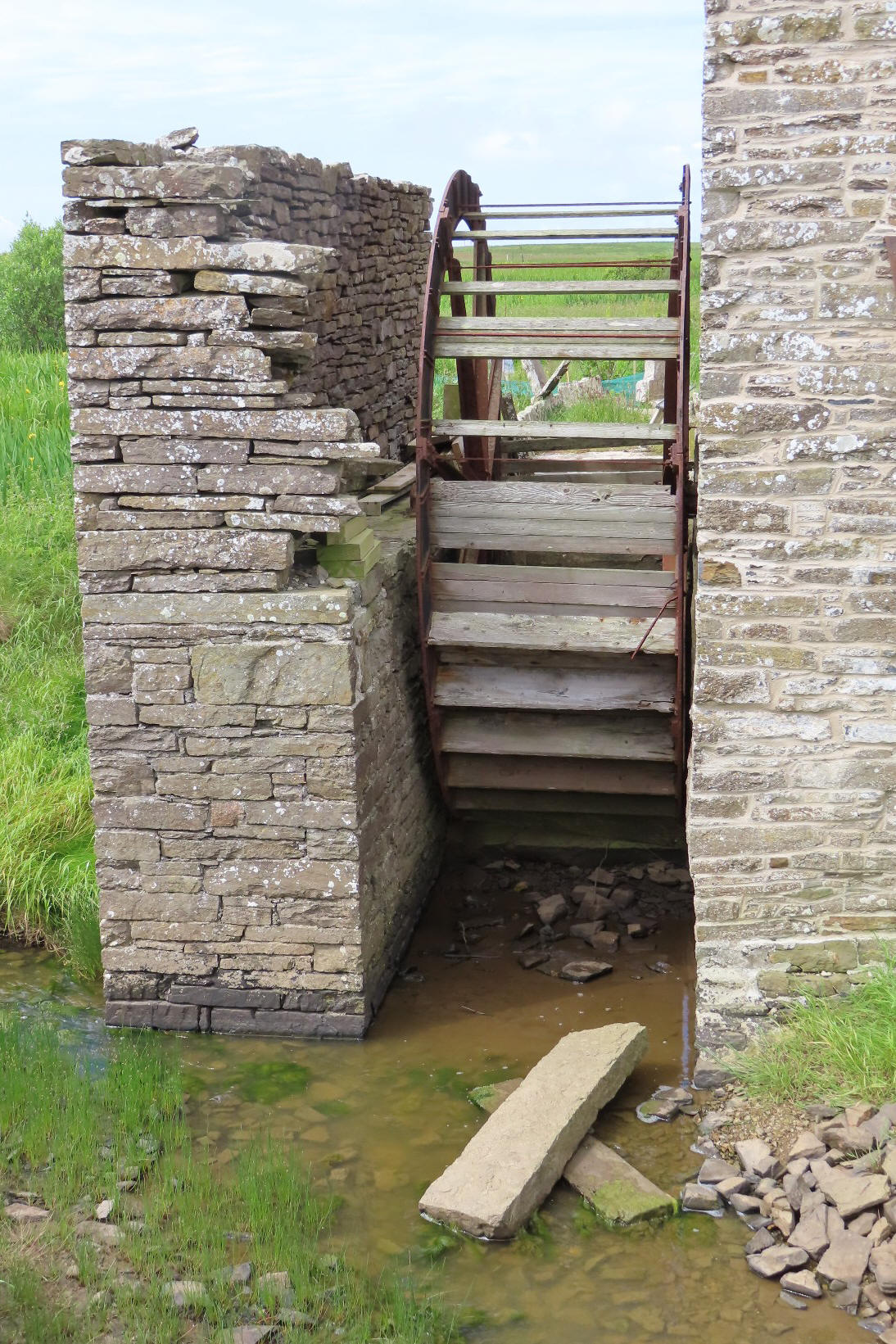 |
|
Finally we looked at the outside of
Tormiston Mill, which was the visitor centre
for Maes Howe neolithic tomb until 2017. This has
now been relocated to Stenness village; ticket
holders take a minibus to the mill and are then
escorted across the road to the tomb. The mill is
empty and unused despite still having most of its
machinery.
Historic Environment Scotland’s description says
“1884–85: Built by Colonel Balfour of
Shapinsay for the convenience of the surrounding
estate tenants and crofters/farmers from the
neighbouring parishes as a mill for preparing animal
feed. The mill is typical of the large
water-powered meal mills built in the late 19th and
early 20th centuries in Orkney and Caithness, with
ironwork from the Thurso Foundry. It is Category B
listed as a building of regional importance. The
mill is a pattern-book example of its period: plain
rectangular plan; three storeys, twin-vented kiln,
three pairs of stones, large cast-iron overshot
wheel and flagstone built lade. Unusually, the lade
is carried on a beautifully built stone aqueduct.
The building’s 1972 conversion won a European
Architectural Heritage Award in 1975.”
|
 |
|
Background information variously from
baronymill,com,
Historic Environment Scotland, Canmore,
rousayremembered.com,
and
orkney.com. |
|
   |
|
|
